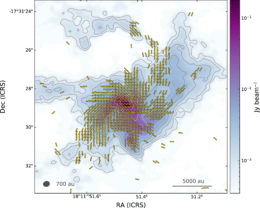What forces are at work in the hidden centers of clouds that are forming baby massive stars? New images reveal the roles played by gravity and whirling magnetic fields.
To Make a Massive Star
High-mass stars of up to 120 solar masses are a critical driver of galaxy evolution: they pump energy into their surroundings and enrich galaxies with heavy elements that can’t be produced elsewhere. Yet massive stars remain shrouded in mystery — in fact, we still don’t fully understand how these behemoths are born.

This false-color infrared image, captured by NASA’s WISE telescope, reveals young, massive stars (pink objects near center) forming in the Rho Ophiuchi cloud complex. [NASA/JPL-Caltech/WISE Team]
On scales of ~2,000–20,000 au, observations suggest that magnetic fields play an important role in funneling material inward to grow the baby star. But observations become more challenging to make on smaller scales — so we still don’t know what’s happening in the innermost ~1,000 au, at the interface between the molecular core and its accretion disk. Do magnetic fields provide useful support on these small scales? Or does gravity dominate, ultimately crushing everything inward?
Peering Into the Dust
In a new study led by Patricio Sanhueza (National Astronomical Observatory of Japan; SOKENDAI, Japan), a team of scientists has now addressed these questions. Using the incredible resolving power of the Atacama Large Millimeter/submillimeter Array (ALMA), Sanhueza and collaborators have probed the gas and dust at scales of ~1,000 au around a hot molecular core embedded in the high-mass star-forming region IRAS 18089–1732.

ALMA observations show the dust (color scale and contours) and the magnetic field vectors at the center of the hot molecular core IRAS 18089–1732. [Sanhueza et al. 2021]
Gravity Is King
What does all this tell us about the physical processes happening in the inner 1,000 au around a newly forming baby star? By analyzing the energy balance of the system, Sanhueza and collaborators show that gravity overwhelms the other processes at work in this region — including turbulence, rotation, and the magnetic field, which all play roughly equal roles in trying to support IRAS 18089–1732 against collapse.
Though magnetic fields exert an important influence on larger scales, they take a back seat in this innermost region where gravity is king. Thus, in the hot, shrouded centers of collapsing molecular clouds, even magnetic whirlpools eventually succumb to the crush of gravity to help form baby stars.
Citation
“Gravity-driven Magnetic Field at ~1000 au Scales in High-mass Star Formation,” Patricio Sanhueza et al 2021 ApJL 915 L10. doi:10.3847/2041-8213/ac081c

